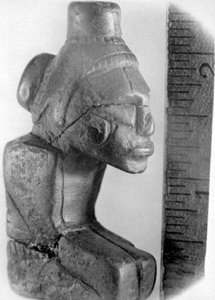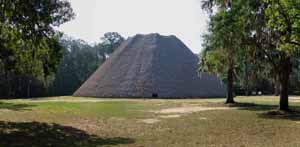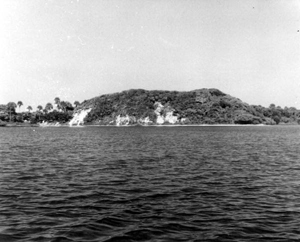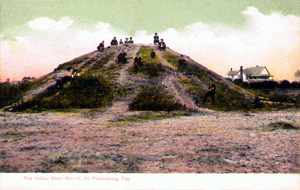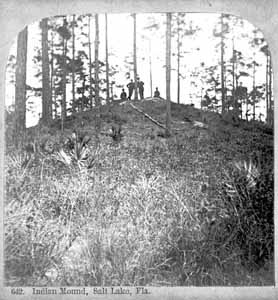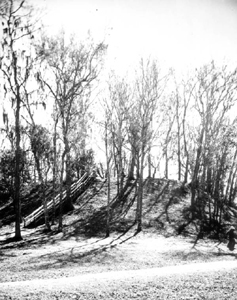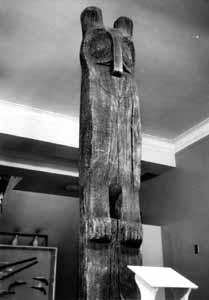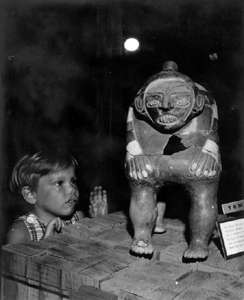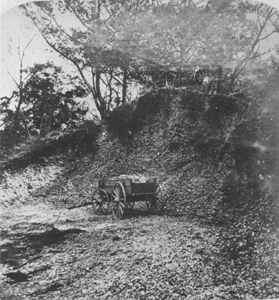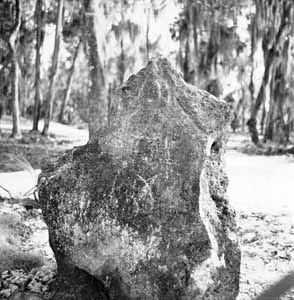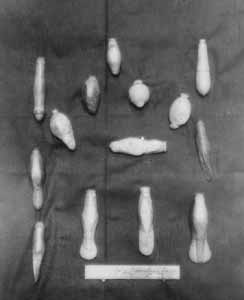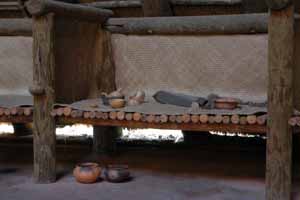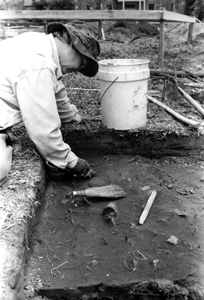Photo Exhibits
Photo exhibits spotlight various topics in Florida history, and are accompanied by brief text intended to place selected materials in historical context.
Images of Florida Seminoles in the Sunshine State
Early Years
The members of the Seminole Tribe of Florida are a central part of Florida's diverse culture and extensive history. Today's Florida Seminoles are the descendents of the mound-building chiefdoms that once prospered throughout the Southeast for over a thousand years in the EARLY YEARS of Florida's human past. It was these societies that first encountered the European explorers in the 1500s and 1600s. Ancestors of modern Seminoles adapted to the new social and biological challenges those Europeans brought, and, in the process, transformed into the historical Seminoles many are familiar with today.
Pre-Columbian figurine found in the Wacissa River (1936)
Image Number: GE1761b
Such figurines, as well as shell carvings and earthen structures, represented the religious and political power exerted throughout the Southeast.
Many such artifacts found in Florida originated thousands of miles away, indicators of the extensive communication, cultural, and trade routes that existed centuries before the arrival of Europeans.
Modern reconstruction of an Apalachee council house at the San Luis Mission site: Tallahassee, Florida (2007)
Image Number: PR30139
Such structures, none of which survive today, give an indication of the power and size of Pre-Columbian cultures in the Southeast. The Apalachees were a powerful agricultural chiefdom that lived in the Big Bend area.
Turtle Mound near New Smyrna Beach, Florida (1930s)
Image Number: RC11673
Earthen and shell mounds such as this one on the East Coast once covered the southeast.
Symbols of both political and religious authority, each mound took thousands of hours to build and maintain and today are almost all that is left of the once powerful chiefdoms that thrived throughout the state.
Pre-Columbian shell mound in St. Petersburg, Florida (c. 1900)
Image Number: PC4008
Earthen mound in Salt Lake, Florida (1900s)
Image Number: N040229
Mound near Lake Jackson in Tallahassee, Florida (1980s)
Image Number: PR10603
Carved owl figurine discovered in the St. Johns River (1955)
Image Number: RC11260
Carved out of pine sometime in the 1300s by the St. Johns culture, this figurine was discovered in the St. Johns River in Deland, Florida in 1955 by Victor Roepke.
Today, it is housed at the Fort Caroline National Monument in Jacksonville, Florida.
Pre-Columbian figurine on display at the Fort Walton Indian Temple Mound Museum (1974)
Image Number: C681993
This was thought to have been a vessel to hold the cremated remains of a political or religious leader in Pre-Columbian Florida.
In some communities, leaders were often thought to be deities. Some of the largest earthen mounds were essentially burial sites for such leaders.
Pre-Columbian shell mound on the East Coast (c. 1900)
Image Number: RC00297
Many of Florida's shell mounds were excavated for both the valuable antiquities as well as for building materials for roads and buildings in the early 20th century. Much Pre-Columbian history was lost as a result.
Limestone stele at Crystal River State Park (1960s)
Image Number: FPS00137
In 1964, Florida archaeologist Ripley Bullen discovered this limestone ceremonial stone (stele). While not all agree with his interpretation, Bullen believed this was purposely erected for ceremonial and celestial purposes
Located 75 yards east of the main burial complex, it dates to 440 A.D. A drawing of what Bullen believed was a human can be seen in this image.
Decorative net weights excavated in Hillsborough County (1937)
Image Number: GE1439
Reconstruction of Apalachee sleeping area at the San Luis Mission site: Tallahassee, Florida (2005)
Image Number: PR20398
Archaeologist excavating Spanish explorer's 1539 winter encampment in Tallahassee (1987)
Image Number: RC13728
To date, this was the only verified site for the entire DeSoto expedition.
His expedition, along with other expeditions and settlements forever changed the Southeast by introducing new religions, forms of government, material culture, and most devastatingly new diseases.
Ancestors to modern-day Seminoles were forced to change and adapt to these new circumstances.

 Listen: The Bluegrass & Old-Time Program
Listen: The Bluegrass & Old-Time Program